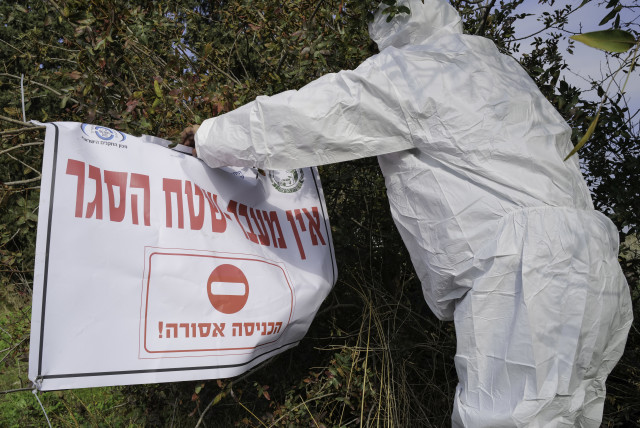Dozens of cranes killed by bird flu in northern Israel

Avian influenza has affected tens of millions of birds and thousands of mammals worldwide in recent years.
Dozens of cranes have been killed in an outbreak of bird flu in the Hula Valley in northern Israel in recent weeks, raising concerns of a large outbreak similar to the one that killed thousands of cranes from 2021-2022.
In light of the outbreak, the Hula Nature Reserve has been closed, according to the Nature and Parks Authority. The Authority is working with government ministries to try and combat the outbreak.
Despite the announcement that government ministries were working to fight the outbreak, as of Thursday, the dozens of crane carcasses in the reserve had not been cleared up, despite the existence of clear policies instituted after the outbreak in 2021-2022.
According to Ynet, there is no budget available for clearing the carcasses, an operation estimated to cost about NIS 5,000 a day due to the war.
Ofer Barnea, CEO of the Upper Galilee Agricultural Co., told Ynet that because the Nature and Parks Authority has stopped feeding the cranes in the Hula Nature Reserve in order to prevent them from crowding together, the cranes have spread to nearby fields, damaging crops.

Efi Naim, the director of the Hula Valley area for KKL-JNF, told Calcalist that in general there are fewer cranes in the Hula Nature Reserve than in past years due to a variety of factors including global warming.
The Society for the Protection of Nature in Israel said it had sent a letter to Agriculture Minister Avi Dichter requesting that his office begin managing the situation immediately in cooperation with the relevant bodies in order to clear out the carcasses.
The Agriculture Ministry has insisted that the handling of the situation is the responsibility of the Nature and Parks Authority and KKL-JNF, not the Agriculture Ministry.
"The unusual event about two years ago in the [Hula] Lake was transferred to our care due to the inability of the other parties to manage the event," added the Ministry. "The budget for handling the event will be provided by the National Security Council. The current incident is minor and limited in radius and the number of birds, therefore the treatment should be carried out immediately by Nature and Parks Authority and KKL-JNF according to the professional guidelines of the Agriculture Ministry."
The latest outbreak in Israel comes just a few weeks after two gulls were found infected with the H5N1 subtype of bird flu near Binyamina-Givat Ada and Holon.
Global bird flu outbreak continues
Since 2021, Europe and the Americas have been suffering from a nearly continuous outbreak of H5N1 avian influenza which has been described as "the largest-ever" on the three continents. The virus has affected tens of millions of birds and thousands of mammals worldwide. Outbreaks of the virus have also become more common in Africa and Asia in the past year and even spread to Antarctica.
According to a new report published by the Royal Society for the Protection of Birds' (RSPB) HPAI Seabird Survey Project last week, tens of thousands of seabirds in the UK have been killed since 2021, with severe declines reported in the breeding numbers of many species in the past few years.
Additionally, an early-release article published by the peer-reviewed journal Emerging Infectious Diseases analyzing scientific literature about bird flu infections in mammals, including humans, in the ongoing global outbreak, found that H5N1 is expanding to new continents and spreading to new species.
The analysis noted that while it could be that the infections are simply being caused by there being more birds infected with the virus, meaning scavengers are more likely to eat infected birds, it could also be that the dynamics of the virus itself are changing. The scientists noted that some studies have shown that mammal-to-mammal transmission may have occurred in infected tigers, minks, and species such as sea lions, although further research is needed.
"If mammal-to-mammal transmission occurs during the current H5N1 panzootic, such transmission could imply that the virus mutated to enable virus replication in mammal tissues," wrote the scientists, adding that some researchers have reported mutations that could indicate an adaptation for infecting mammals, although further research is needed.
In China, the National Health Commission of the People’s Republic of China notified the World Health Organization (WHO) in late January that they had found a confirmed case of a woman infected with both the H10N5 strain of the bird flu and the H3N2 strain of the regular seasonal flu. This is the first such case of human infection with H10N5.
The WHO stated that "currently available epidemiologic information suggests that avian influenza A(H10Nx) viruses have not acquired the capacity for sustained transmission among humans. Thus, the likelihood of human-to-human spread is considered low."
Additionally, last week, Agriculture Secretary Tom Vilsack told Congress that the US is about 18 months away from being able to find a vaccine that can address the current strain of avian influenza spreading among poultry. "The problem of course is it mutates so you have to basically create ultimately a vaccine that is available for all strains," said Vilsack, noting as well that there are questions concerning how to vaccinate the hundreds of thousands of birds that would need to be vaccinated.
